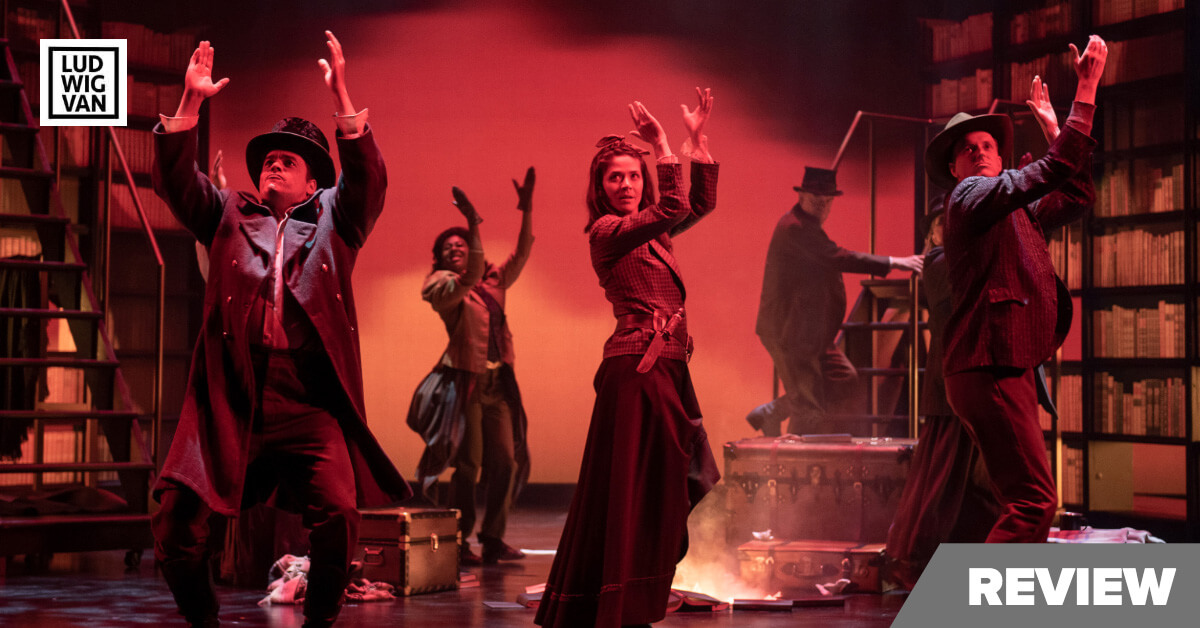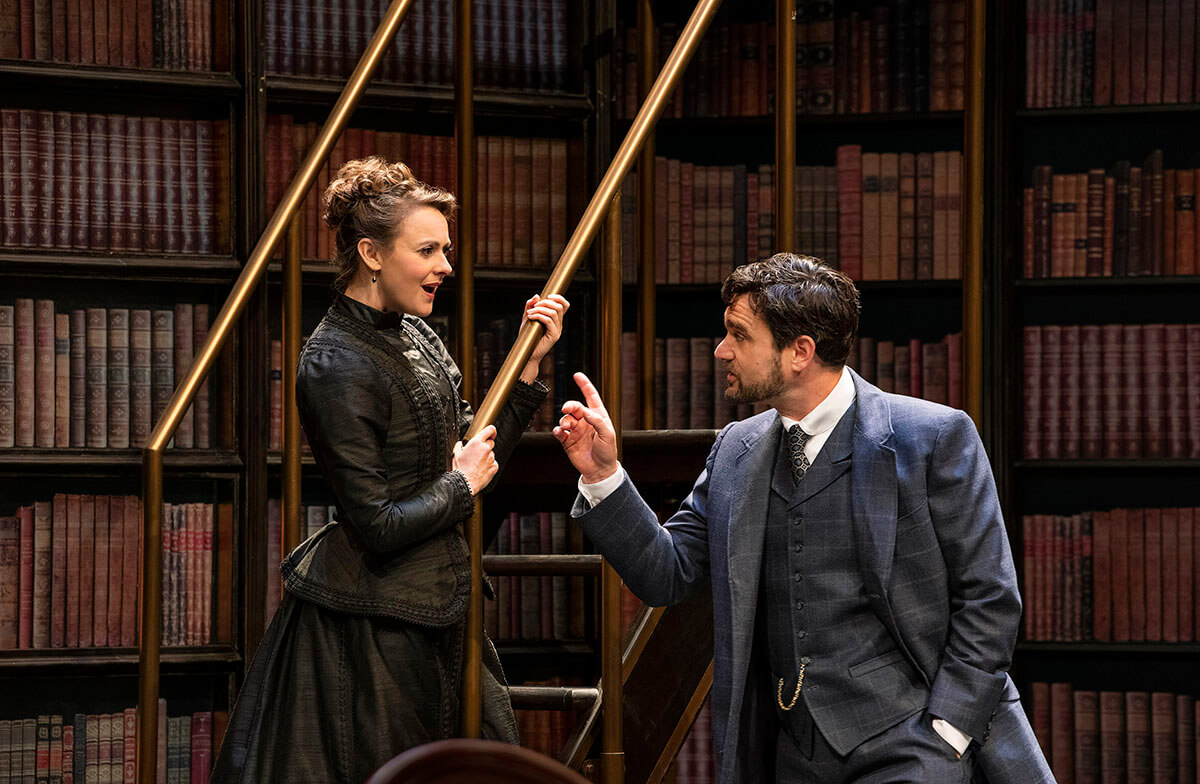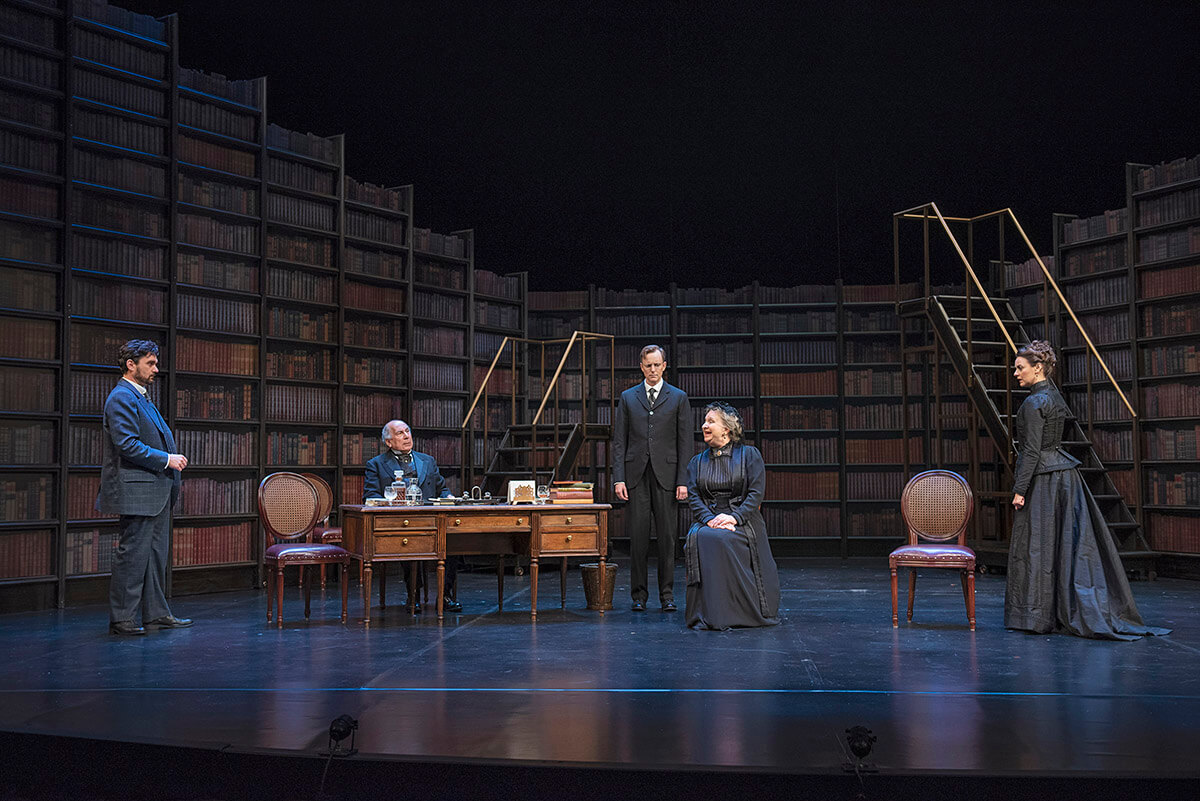
Shaw Festival 2019/ Man and Superman by George Bernard Shaw, directed by Kimberley Rampersad, Festival Theatre, Aug. 17 to Oct. 5. Tickets available at shawfest.com.
The Shaw Festival’s complete Man and Superman (1903) takes six and a half hours (including intermissions) and is worth every second. Shaw’s dizzying torrent of words and ideas has been given a sparkling production that includes an outstanding ensemble of actors, deft direction from Kimberley Rampersad, an imaginative set by Camellia Koo, atmospheric lighting by Kevin Lamotte, and cheeky original music by Joseph Tritt. It’s a must-see because a fully staged version of Man and Superman does not come our way often. The last complete offering at the Shaw Festival was in 2004.
Shaw just didn’t write plays. He also wrote scholarly prefaces and appendices that sometimes are as long as the plays themselves. Man and Superman is dedicated to Arthur Bingham Walkley, the drama critic of The Times, who suggested that Shaw write a Don Juan play. In his “Epistle Dedicatory”, the witty introduction to Man and Superman, Shaw explains that because he was against the sappy (my word) romantic drama currently being presented on theatre stages, Walkley challenged him to show how a love theme should be developed using Don Juan. Shaw was intimately acquainted with the subject matter because he considered Mozart’s Don Giovanni (1787) one of the greatest operas ever written, which is how the opera characters ended up in Man and Superman.
The usual staging of the play is to present Acts One, Two and Four, which make for a complete vehicle on their own. The inclusion of the Act Three dream sequence, titled Don Juan in Hell, is what pushes the theatrical experience into mega hours. Within the context of the play, this act, which includes Don Juan, Doña Ana, The Statue (Commendatore) and The Devil, are alter egos for major characters in Man and Superman. The quartet discusses, argues, deliberates, examines and debates the themes and ideas presented in the first two acts to, obviously, a much greater depth.
Shaw being Shaw, everything is turned on its head, with Hell being the destination of choice, a veritable pleasure garden of vices, as it were, because Heaven is too boring. Don Juan in Hell is Shaw at his didactic best, and by seeing Act Three, we have a richer understanding of Shavian tropes that are dear to the master’s heart. The complete presentation of Man and Superman transforms an otherwise charming and provocative comedy of manners into a dazzling philosophical discourse of epic proportions. Admittedly, Don Juan in Hell does flag a bit, in comparison to the more concise dialogue of the other three acts, overburdened as it is by enough themes to sink a battleship, but it is fascinating nonetheless, given all the twists and turns of Shaw’s polemic.
In her program notes, director Rampersad states that she sees the play’s hero, John Tanner (Gray Powell), as an avatar of Shaw himself. The name John Turner is apparently a direct translation from the Spanish Don Juan Tenorio, whom, we are told, is an ancestor of Tanner. The latter is an iconoclast, as is Shaw, and Tanner has supposedly written a subversive tome entitled The Revolutionist’s Handbook and Pocket Companion (which, believe it or not, Shaw included as an appendix in the published edition of the play.) Shaw called Man and Superman “A Comedy and a Philosophy”, and out of the mouth of Tanner comes Shaw’s own progressive views on a staggering array of subjects. Nonetheless, if Man and Superman can be reduced to one sentence, it would be this: a man does not stand a chance when a woman, filled with the life force, the élan vital as it were, is intent on marriage. And a further statement would be, this life force, when imbued in superior women, ensures that the race of humankind will evolve to produce greater beings, a superman, as it were.
The last thing the quartet of characters talks about in Don Juan in Hell is the evolution of such a superman, and Doña Ana closes the dream sequence with: “Not yet created! Then my work is not yet done… A Father! A father for the Superman!” John Tanner, caught in the grip of Ann Whitefield’s life force, ends the play railing against marriage as a loss of happiness and freedom, but marriage it will be. In fact, each of the characters in the play represents different perspectives on love, marriage and life in general.

The Shaw ensemble has always been a rich mother lode of sterling actors, but there were stumbles in the opening performance, particularly from Powell. John Tanner/Don Juan Tenorio is a gigantic role for an actor in terms of lines. In fact, people throughout the play complain that Tanner won’t stop talking. Powell does a magnificent job with his cascade of verbiage, but he did have a few false starts for some of the speeches. Once he got into the swing of his rhythm, however, he was unstoppable. In one instance, he did scramble a speech so badly he had to throw it away, but with class, he acknowledged his flub to the audience, and we laughed with him. From the onset, Powell swaggers across the stage, brash and confident, convinced of Tanner’s own rightness of things. His character is vital and alive, and his John Tanner is a totally compelling presence.
There is so much crisscrossing going on between the Shaw and Stratford Festivals these days, you never know who is going to end up where. For many years Sara Topham (Ann Whitefield/Doña Ana de Ulloa) was a leading lady at Stratford, and now she is in her second season doing big roles at Shaw. I have never cared much for the hypocritical character of Ann Whitefield who is, according to Tanner, a liar, a coquette and a bully, and, happily, Topham captures her duplicitous nature perfectly and so conforms to my dislike. Butter wouldn’t melt in Topham’s mouth, and she makes Ann’s scheming so patently obvious that she becomes more irritating by the minute. It’s a hard role to play, sweet and dislikeable at the same time, but Topham nails it.
In a clever bit of gender-bending, Martha Burns plays the dual male role of the lovesick brigand Mendoza and The Devil, and how nice to see this accomplished actor back in live theatre. Crisp and clean in her attack, Burns conveys a sense of the paradoxes of her two characters — her poetry-writing robber, and her gracious hostess Lucifer. Burns telegraphs to the audience that she is sharing a joke with us, mocking herself as it were. Casting Mendoza/The Devil as a woman is in keeping with Shaw’s strong woman theme in Man and Superman, which includes the dominating Ann Whitefield and her life force, and the other strong woman in the play, the ever-practical Violet Robinson.
Each time I see Courtney Ch’ng Lancaster, either as an actor or director, I am more impressed. Violet is the sister of the dreamy, idealistic poet/novelist Octavius Robinson (Kyle Blair), and is his polar opposite. Without ever raising her voice, Lancaster smoothly delivers Violet’s steel magnolia persona. She’s got her man Hector Malone (Jeff Irving) as well as his father (Tom McCamus) well under control. Violet is a force of nature, and is clearly an assured woman making her own pathway in the world. As for the great Sharry Flett, twenty-nine seasons at the Shaw, she is, as always, simply lovely and gracious as the put upon Mrs. Whitefield, Ann’s mother. We clearly see she loves her daughter but doesn’t like her. Flett’s melodious voice and sweet demeanour encompass the charms of a Victorian lady who is bred in the bone. Tanja Jacobs is always very good at playing gruff women, and her tough, stern and judgemental spinster Susan Ramsden is the quintessential rock hard prude
I took notice of talented west coast actor David Adams last year. He plays the dual role of the ultra-conservative lawyer Roebuck Ramsden, a Whitefield family friend, and the more jolly and forgiving Statue, and is a good addition to the Shaw Festival, taking on the elder statesmen roles vacated by retiring ensemble veterans. Adams is one of those actors who inspires confidence. You know his characterizations will be strong and pointed. His Ramsden is not an old fogy buffoon, because Adams gives him the dignity that is his due. Sanjay Talwar has the plum role of the cockney chauffeur Henry Straker, one of Shaw’s New Men who have come out of the working class to take their place alongside the aristocracy. Straker treats everyone as his equal, and has some of Shaw’s best put down lines. Never diffident, Talwar’s Straker speaks to the future — a small role, but a strong presence on stage.

Blair has the thankless task of playing the artistic Octavius who is hopelessly in love with Ann. He also could be a buffoon, but Blair is a very good actor who stops short of caricature. At the mercy of both Ann and his sister Violet, Blair’s Tavy is a believable romantic, but he also manifests loyalty to his friend Tanner, respect to Ramsden, and befuddlement about women in general. In other words, he makes a stereotype a bit complicated. Both Malones are Americans, and Irving and McCamus have broadened their vowels to sound definitely from south of the border, in contrast to the mix of mid-Atlantic-cum-British accents of the rest of the cast. These two are really the least fleshed-out characters in the play, but both give strong performances, the former as a spoiled son who does manage to finally show some mettle, the latter as an obscenely rich manufacturer who knows his own mind, except when they are both faced with a strong woman in the guise of Violet. In the Don Juan in Hell act, outside the four main protagonists, everyone else in the cast, including Shauna Thompson and Jason Cadieux, portray brigands of various political stripes and rip right into the chaos of their roles.
Rampersad has directed with restless energy, moving her characters into various positions around the stage, She is also a choreographer who manages her actors like dancers on a chessboard. They flit from this chair to that, up this staircase or down that one, and her style works, underpinning the relentless nature of Shaw’s argumentative style. Her constantly shifting movement patterns add zest and zing to the static nature of Shaw’s dialogue. She also has crafted a very sexy ending, when John Tanner can’t help himself in grabbing Ann in a steamy embrace. Shaw and sexy don’t often go together.
Rampersad is helped by Koo’s set whose central them is books, as in words, as in Shaw’s verbal avalanche. The set of Ramsden’s study is ringed with books that features two portable staircases to get to the upper stacks. The driveway to Mrs. Whitefield’s house has pine trees imprinted on bookcases. The brigands’ Sierra Nevada Mountains are made up of books with the staircases as added lookout stands. A backdrop of books forms the villa garden in Granada. The play ends with pages from books falling from the sky – an apt metaphor for the Shavian flood of words and ideas. Lamotte’s lighting is masterful, particularly the transition from the brigands’ camp to the dream sequence of Don Juan in Hell, black to red and shades in between. From a dusty study, to a shadowy mountain camp, to the blinding sun of Granada, Lamotte lights Koo’s set beautifully. Rampersad has set the period when the play was written, and Koo has provided attractive Edwardian costumes, going back to showy eighteenth-century garb for Don Juan in Hell. Everyone looks gorgeous.
As for Tritt’s original music, it is bold indeed. Rampersad, presumably, has directed Adams/Ramsden and Blair/Octavius, who begin the play, to singspiel the dialogue like it is recitative in an opera, and Tritt has provided the electronic harpsichord accompaniment. It sounds straight from Mozart, and I was just waiting for one of them to break out into an aria. The music that begins the brigand third act is Carmenesque, but not quite, while much of the other incidental music is riffs from Don Giovanni itself, all of which is very cleverly integrated into the play.
All in all, this complete production of Man and Superman pays due respect to Shaw’s wit and wisdom in the most engaging way.
LUDWIG VAN TORONTO
Want more updates on classical music and opera news and reviews? Follow us on Facebook, Instagram or Twitter for all the latest.
- INTERVIEW | Actor Diego Matamoros Takes On Icon Walt Disney In Soulpepper Production Of Hnath Play - April 16, 2024
- SCRUTINY | Opera In Concert Shine A Light On Verdi’s Seldom Heard La Battaglia Di Legnano - April 9, 2024
- SCRUTINY | Lepage & Côté’s Hamlet Dazzles With Dance And Stagecraft Without Saying Anything New - April 5, 2024



